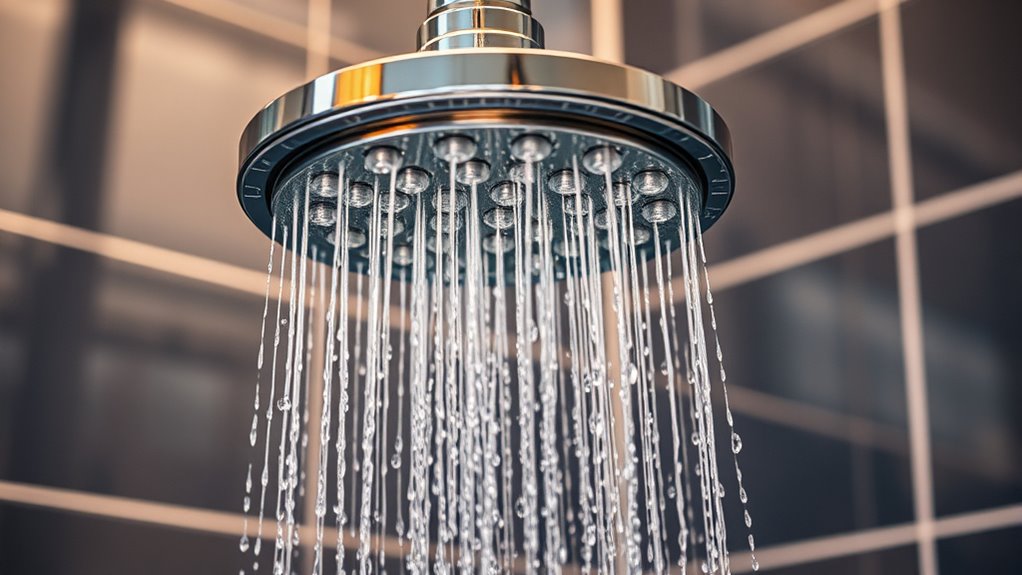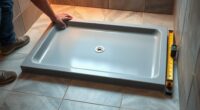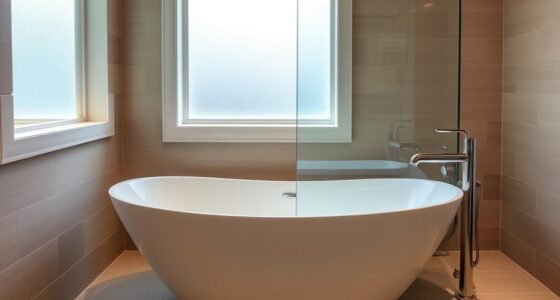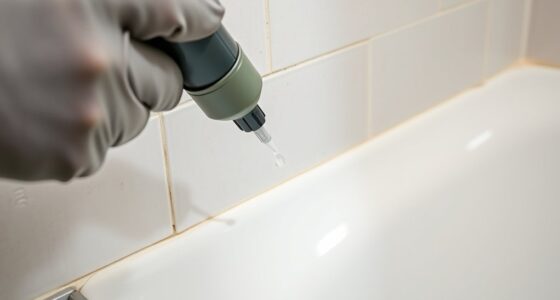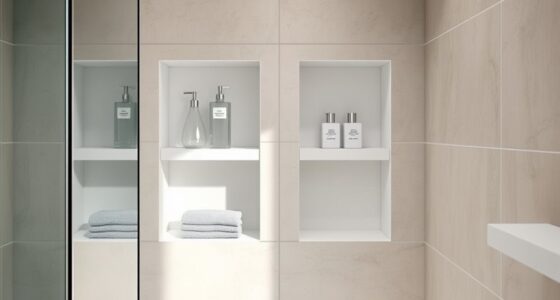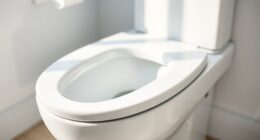If you want a more invigorating shower, start by checking your main water valve to make sure it’s fully open. Clean or replace clogged showerheads, and verify your pipes and water heater aren’t corroded or full of mineral deposits, as these can restrict flow. Installing a pressure regulator or pump can also boost water pressure. For best results, regular maintenance and professional advice can help uncover hidden issues and improve your shower experience. Keep exploring to learn more tips!
Key Takeaways
- Inspect and replace corroded pipes with corrosion-resistant materials like PEX or copper.
- Clean or replace the showerhead to remove mineral deposits blocking water flow.
- Install a pressure regulator or water pump to increase overall water pressure.
- Flush and clean the water heater tank to eliminate sediment buildup restricting hot water flow.
- Ensure the main water shut-off valve and any pressure-boosting devices are fully open and properly functioning.
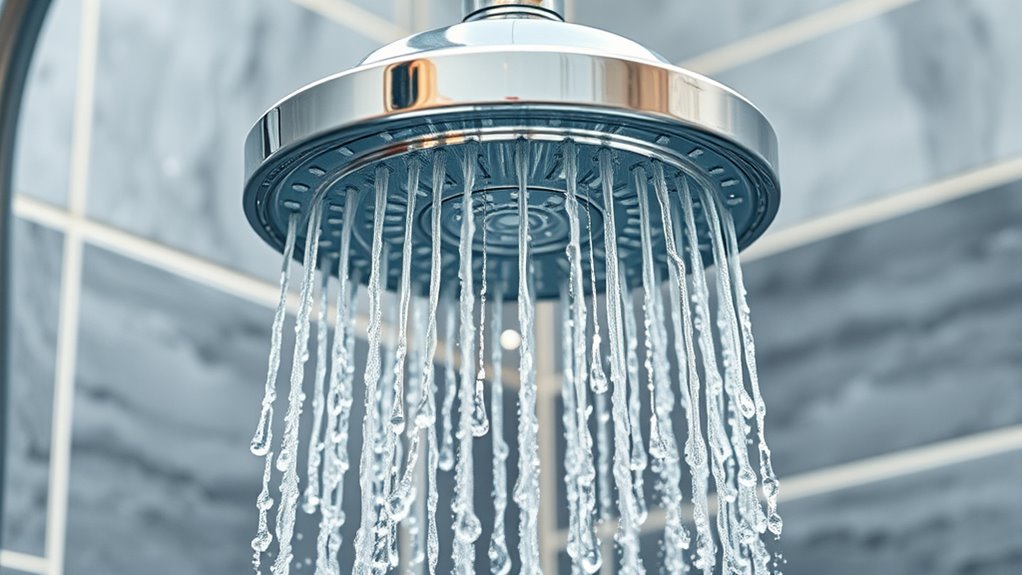
If your shower water feels weak or takes too long to rinse away soap, boosting the water pressure can make a notable difference. Before diving into solutions, it’s essential to understand what might be causing low pressure. Often, pipe corrosion plays a major role. Over time, mineral buildup and corrosion inside your pipes can restrict water flow, reducing pressure at your showerhead. If your plumbing system is aging or you haven’t been maintaining it, this buildup can considerably hinder water flow, making your shower less effective. Additionally, your water heater can impact pressure levels. A water heater that’s too small, malfunctioning, or set too low can restrict hot water flow, leading to a weaker shower experience. Sometimes, sediment accumulation inside the water heater tank can clog outlets and reduce pressure, especially in areas with hard water. Regular maintenance and inspections can help identify these issues early. To address pipe corrosion, start by inspecting your plumbing system. If corrosion is evident or you notice discolored water, it’s a good idea to replace affected pipes. Installing newer, corrosion-resistant materials like PEX or copper can help prevent future buildup and improve water flow. Flushing out your water heater is another practical step. Sediment buildup inside the tank can cause pressure issues, so draining and cleaning it periodically can restore better flow. Also, check the water heater’s temperature setting; setting it too low may restrict hot water flow, while setting it too high could cause mineral buildup that hampers performance. If pipe corrosion or sediment buildup isn’t the issue, consider installing a pressure-boosting device. A pressure regulator or a pump can considerably increase water flow to your shower. These devices are especially useful if your home’s water pressure is naturally low or if municipal supply limitations are a factor. Before doing so, measure your current water pressure with a gauge, so you know what kind of boost you need. Sometimes, the problem may be as simple as mineral deposits clogging your showerhead. Remove and clean or replace the showerhead to improve flow. A clogged showerhead acts like a partial block, reducing water velocity and making your shower feel weak. Additionally, checking for water pressure issues and considering a pressure booster can be effective solutions. Finally, check your home’s main water shut-off valve. If it’s partially closed or obstructed, water flow will be compromised. Ensuring the valve is fully open can immediately boost pressure. If all else fails, consulting a plumber can help identify underlying issues like hidden pipe corrosion or problems with your water heater that aren’t immediately visible. Taking these steps will help you enjoy a more revitalizing, powerful shower.
Frequently Asked Questions
Can Low Water Pressure Be Caused by Municipal Supply Issues?
Yes, low water pressure can be caused by municipal supply issues. If the municipal system faces maintenance problems, drought, or infrastructure limitations, it can reduce water flow to your home. You might notice weaker pressure especially during peak usage times. Contact your water provider to check for ongoing issues or restrictions. Sometimes, municipal supply problems are temporary, but persistent low pressure might require you to inspect your plumbing for other causes.
How Often Should Showerheads Be Cleaned to Maintain Pressure?
You should clean your showerhead every 1 to 3 months to maintain ideal pressure. Establishing a regular maintenance schedule helps prevent mineral buildup and clogs that reduce water flow. If you notice decreased pressure, it’s time to clean more frequently. Remove the showerhead, soak it in vinegar, and scrub away deposits. Staying consistent with your cleaning frequency ensures a revitalizing, high-pressure shower every time.
Will Replacing My Shower Valve Improve Water Flow?
Think of your shower valve as the captain steering your water flow ship. Replacing your shower valve can markedly improve water flow, especially if it’s old or clogged. Upgrading it acts like giving your captain a better map, leading to smoother, more powerful streams. So, yes, swapping out that valve could be just what you need to transform your shower into a invigorating oasis, with consistent, satisfying water pressure.
Are There Eco-Friendly Solutions to Increase Shower Pressure?
You can increase your shower pressure using eco-friendly solutions like water-saving showers and eco-friendly aerators. These devices improve water flow without wasting resources, making your shower feel more invigorating. Installing water-saving showers ensures you get a satisfying rinse while conserving water, and eco-friendly aerators add air to the water stream for better pressure. These options are both effective and environmentally conscious, giving you a powerful shower experience while helping the planet.
How Does Pipe Diameter Affect Water Pressure in the Shower?
Imagine your shower as a gentle dance of water—pipe diameter plays a vital role in this flow. Larger pipes allow more water flow, reducing pressure loss and giving you that invigorating shower you crave. Conversely, narrower pipes can restrict water flow, making your shower feel less revitalizing. So, increasing pipe diameter can substantially improve water pressure, ensuring a more satisfying and energizing wash every time.
Conclusion
So, now you’re all set to turn that tepid trickle into a mighty cascade. Who knew that a few simple tricks could transform your shower from a sad drip to a glorious deluge? Just remember, with great pressure comes great responsibility—so don’t flood the bathroom or start a waterpark in your house. Happy splashing! Now go forth and conquer your shower, one powerful spray at a time.
